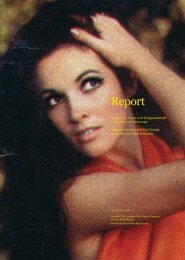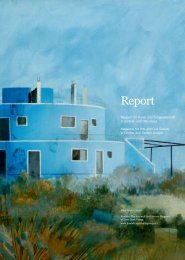Report_Issue 1/2009 - Jubiläum/ 20 Jahre Mauerfall
Report_Issue 1/2009 - Jubiläum/ 20 Jahre Mauerfall
Report_Issue 1/2009 - Jubiläum/ 20 Jahre Mauerfall
Sie wollen auch ein ePaper? Erhöhen Sie die Reichweite Ihrer Titel.
YUMPU macht aus Druck-PDFs automatisch weboptimierte ePaper, die Google liebt.
“The history of contemporary<br />
art in this<br />
collection is a history<br />
of ‘neighbourhoods’”<br />
Outline portraits of five members of the international jury for “Kontakt. The Art Collection<br />
of Erste Group” of contemporary and modern art: Silvia Eiblmayr, Jiří<br />
Ševčík, Branka Stipančić, Adam Szymczyk, Georg Schöllhammer.<br />
Jirˇí Ševčík “I expect that the collection will<br />
fill a gap that exists in most of the museum<br />
collections, by showing some displaced phenomena<br />
from the subconscious. I am looking<br />
forward to the collection containing a high<br />
concentration of significant works of Eastern<br />
European art, which are based on a different<br />
reality, different experiences and different<br />
times. The collection can also show what<br />
we do not really want to learn about each<br />
other. And, above all, it can provide impulses<br />
by processing new experiences that still lie<br />
ahead of us. By this I mean that we will have<br />
to fit into our experience something which,<br />
surprisingly, is also our reality, and that we<br />
will have to learn how to live with something,<br />
that, while it is not completely foreign, still<br />
doesn’t correspond with established standards.”<br />
Jiří Ševčík was, from 1962 to 1965, among other<br />
things, editor-in-chief of the magazine Architektura CSR.<br />
He taught at the Institute for Theory and History of Art<br />
and Architecture in Prague School of Architecture from<br />
1966 to 1989. Since 1996 he has been vice-rector of<br />
the Academy of Applied Art in Prague and, in addition,<br />
since 1997 head of the research centre and archive of<br />
Czech art.<br />
Silvia Eiblmayr “The study of the art of the<br />
former socialist, now post-socialist, countries<br />
has always formed part of my interests as a<br />
curator, something that is also reflected in<br />
the work on building up this collection. In this<br />
context an experience I have regularly had<br />
when making exhibitions should also prove<br />
fruitful: namely, that when artistic works<br />
are placed in a selected context or special<br />
thematic setting they become aesthetically<br />
productive and unlock meanings never previously<br />
noticed. The intention is that, by means<br />
of focussed cross-connections, the collection<br />
should make a hermeneutic contribution to<br />
the historic and current understanding and<br />
interpretation of those intellectual, cultural<br />
and political fields that the countries involved<br />
share with each other or through which they<br />
differ.”<br />
Silvia Eiblmayr is an art historian. From 1988 to <strong>20</strong>04<br />
she worked as a lecturer at the Academy of Fine Arts<br />
in Vienna, at the Kunsthochschule für Medien Cologne<br />
and at Zurich University. From 1999–<strong>20</strong>08 she was director<br />
of the Galerie im Taxispalais, Innsbruck. In <strong><strong>20</strong>09</strong><br />
she curated the Austrian Pavilion at Biennale Venice together<br />
with VALIE EXPORT.<br />
Branka Stipančić “It is a known fact that<br />
there are collections of contemporary art<br />
in numerous Eastern and South-Eastern<br />
European countries lying in the storerooms<br />
because museums have no adequate buildings<br />
in which to show such collections to the<br />
public. Some examples are the remarkable<br />
ArtEast Collection <strong>20</strong>00+ of the Modern<br />
Gallery in Ljubljana, as well as the collection<br />
of international art of the Contemporary Art<br />
Museum in Zagreb. I strongly believe that<br />
the collection will connect different cultural<br />
spaces which have, until recently, been rather<br />
isolated and that it will present to the public<br />
artworks that – for reasons that had nothing<br />
to do with art – have remained unknown<br />
for a number of years. Furthermore, I have<br />
no doubt that the collection will encourage<br />
numerous discussions and will contribute to a<br />
better understanding of contemporary art.”<br />
Branka Stipančić is an art critic and free-lance art historian<br />
who lives and works in Zagreb (Croatia). From<br />
1983 to 1993 she was a curator at the Museum of Contemporary<br />
Art in Zagreb and director of the Soros Center<br />
for Contemporary Art in Zagreb from 1993 to 1996.<br />
Georg Schöllhammer “What particularly<br />
interests me about this collection – in addition<br />
to the hope that it may help to correct<br />
a certain imbalance evident in the writing of<br />
art history of recent decades – is the reflection<br />
on the consequences of a ‘global cultural<br />
flow’. The collection will thematically concentrate<br />
something and then release it again<br />
and allow it to work in different contexts,<br />
also in the region of origin. And this will be<br />
accompanied by research grants, publications,<br />
a documentation of context material<br />
and a well thought-out series of additional<br />
measures that are intended to have a local<br />
effect. Something frequently overlooked in<br />
the current version of the universal talk about<br />
the globalisation of art and in many private<br />
collections is particularly important to the<br />
founding jury: namely that the ethos of locality<br />
is specific quality of artistic life. Our aim<br />
would therefore be to narrate the history of<br />
contemporary art in this collection as a history<br />
of “neighbourhoods” i.e. of more or less<br />
isolated and unstable systems of reference.<br />
Adam Szymczyk “The Erste Bank Collection is<br />
taking a distinctly different and new direction<br />
by opening up to art from Eastern and Central<br />
Europe. The geographic area on which the<br />
collection focuses is not (and should not be)<br />
too narrowly defined. Its main orientation is<br />
art that has, to a large extent, so far escaped<br />
the attention of major (in this case Western<br />
European) private and public collections. We<br />
believe that the collection could make an<br />
important contribution towards a broader understanding<br />
of phenomena in contemporary<br />
art of the last forty years. Many works that<br />
will become a part of the collection are hardly<br />
known in Western Europe, even to art professionals.<br />
Therefore the collection will have an<br />
important educational aspect and, hopefully,<br />
will make it possible to redefine some of the<br />
existing dogmas of recent art history.”<br />
Adam Szymczyk since <strong>20</strong>03 has been director of the<br />
Kunsthalle Basel. From 1994 to 1995 he was curatorial<br />
assistant for film and video at the Centre for Contemporary<br />
Art in Warsaw. He was also curator for the Foksal<br />
Gallery Foundation in Warsaw from 1997 to <strong>20</strong>03. In<br />
the past decade he has worked on exhibitions and publications<br />
of and about artists such as Pawel Althamer,<br />
Douglas Gordon, Susan Hiller, Job Koelewijn, Edward<br />
Krasinski, Piotr Uklanski, Krzysztof Wodiczko.<br />
We hope as a result to also be able to contribute<br />
to a history of recent art as a technique<br />
that produces locality. At the same time we<br />
hope that this viewpoint will help to reveal the<br />
extent of the role played in the production of<br />
the respective categories by artists, intellectuals,<br />
museum experts, gallery owners, local<br />
politics and the social, media and economic<br />
field of tension. My hope is that, in building<br />
up the collection over the next few years,<br />
we may succeed in working in this direction.<br />
Although it may sound paradoxical, I would<br />
describe this as a political task.”<br />
Georg Schöllhammer is director of tranzit Österreich,<br />
a culture journalist and curator. From 1988 to 1994 he<br />
wrote for the Austrian daily newspaper “Der Standard“.<br />
Since 1992 Schöllhammer has lectured on the theory<br />
of contemporary art as a visiting professor at the University<br />
for Visual and Industrial Design in Linz, Austria. He is<br />
editor-in-chief with responsibility for the text content of<br />
“springerin – Hefte für Gegenwartskunst“ and the publisher<br />
of a series of publications of documenta 12.<br />
Published in “<strong>Report</strong>” in April <strong>20</strong>05 (online).<br />
91




